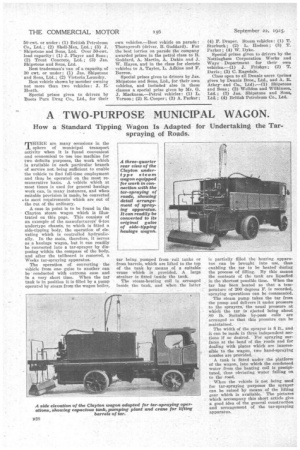A TWO-PURPOSE MUNICIPAL WAGON.
Page 12

If you've noticed an error in this article please click here to report it so we can fix it.
How a Standard Tipping Wagon Is Adapted for Undertaking the Tarspraying of Roads.
rpHEau are. many occasions in the
sphere of municipal transport activity when it is found convenient and economical to use one machine for two definite purposes, the work which is available in each particular branch of service not being sufficient to enable the vehicle to find full-time employment and thus be operated on the most remunerative basis. A vehicle which at most times is used for general haulage work can, in many instances, and when suitable provision is made; be converted • to meet requirements which are out of the rut of the ordinary.
A case in point is to be found in the Clayton steam wagon which is illustrated on this page. This consists of an example of the manufacturers' 6-ton undertype chassis, to which is fitted a side-tipping body, the operation of elevating which is controlled hydraulically. In the main, therefore, it serves as a haulage wagon, but it can readily be converted into a tar-sprayer by disposing within the compass of the body, and after the tailboard is removed, a Weeks tar-spraying apparatus.
The operation of converting the vehicle from oneguise to another can be • conducted with extreme ease and in a very short time. When the tar tank is in position it is filled by a pump operated by steam from the wagon boiler,
tar being pumped from rail tanks or from barrels, which are lifted to the top of the tank by means of a suitable crane which is provided. A large strainer is fitted inside the tank.
The steam-heating coil is arranged inside the tank, and when the latter
is partially filled the heating apparatus can be brought into use, thus enabling the tar to be heated during the process of filling. By this means the contents of the tank are liquefied in the shortest possible time. When the tar has been heated so that a temperature of 200 degrees F. is recorded, spraying operations can be commenced.
The steam pump takes the tar from the pump and delivers it under pressure to the sprayers, the usual pressure at which the tar is ejected being about 80 lb. Suitable by-pass coils are arranged so that this pressure can be maintained.
The width of the sprayer is 8 ft., and it can be made in three independent sectiens if so desired. For spraying surfaces at the bend of the roads and for dealing with places which are inaccessible to the wagon, two hand-spraying nozzles are provided.
A tank is fitted under the platform of the wagon, into which the condensed water from the heating coil is precipitated, thus obviating water falling on to the road.
When the vehicle is not being used for tar-spraying purposes the sprayer can be raised by means of the lifting gear which is available. The pictures which accompany this short article give a good idea of the general construction and arrangement of the tar-spraying apparatus.




























